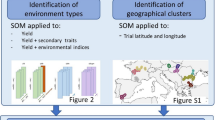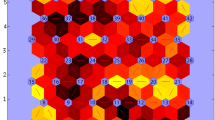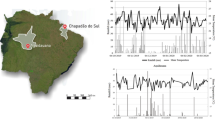Abstract
The selection of better-evaluated genotypes for a target region depends on the characterization of the climate conditions of the environment. With the advancement of computer technology and daily available information about the weather, integrating such information in selection and interaction genotype × environment studies has become a challenge. This article presents the use of the technique of artificial neural networks associated with reaction norms for the processing of climate and georeferenced data for the study of genetic behaviors and the genotype × environment interaction of soybean genotypes. The technique of self-organizing maps (SOM) consists of competitive learning between two layers of neurons; one is the input, which transfers the data to the map, and the other is the output, where the topological structure formed by the competition generates weights, which represent the dissimilarity between the neural units. The methodologies used to classify these neurons and form the target populations of environments (TPE) were the discriminant analysis (DA) and the principal component analysis (PCA). To study soybean genetic behavior within these TPE, the random regression model was adopted to estimate the components of variance, and the reaction norms were adjusted through the Legendre polynomials. The SOM methodology allowed for an explanation of 99% of the variance of the climate data and the formation of well-structured TPE, with the membership probability of the regions within the TPE above 80%. The formation of these TPE allowed us to identify and quantify the response of the genotypes to sensitive changes in the environment.




Similar content being viewed by others
References
Alves RS, de Resende MDV, Azevedo CF, Silva FF, Rocha JRASC, Nunes ACP, Carneiro APS, dos Santos GA (2020) Optimization of Eucalyptus breeding through random regression models allowing for reaction norms in response to environmental gradients. Tree Genet Genomes. https://doi.org/10.1007/s11295-020-01431-5
Bourret A, Bélisle M, Pelletier F, Garant D (2015) Multidimensional environmental influences on timing of breeding in a tree swallow population facing climate change. Evol Appl. https://doi.org/10.1111/eva.12315
Brawner JT, Hodge GR, Meder R, Dvorak WS (2014) Visualising the environmental preferences of Pinus tecunumanii populations. Tree Genet Genomes. https://doi.org/10.1007/s11295-014-0747-8
Bustos-Korts D, Boer MP, Layton J, Gehringer A, Tang T, Wehrens R, Messina C, de la Vega AJ, van Eeuwijk FA (2022) Identification of environment types and adaptation zones with self-organizing maps; applications to sunflower multi-environment data in Europe. Theor Appl Genet 135(6):2059–2082. https://doi.org/10.1007/S00122-022-04098-9/FIGURES/10
Calus MPL, Bijma P, Veerkamp RF (2004) Effects of data structure on the estimation of covariance functions to describe genotype by environment interactions in a reaction norm model. Genet Sel Evol. https://doi.org/10.1051/gse:2004013
Chen N, Chen L, Ma Y, Chen A (2019) Regional disaster risk assessment of China based on self-organizing map: clustering, visualization and ranking. Int J Disaster Risk Reduct 33:196–206. https://doi.org/10.1016/J.IJDRR.2018.10.005
Chenu K, Deihimfard R, Chapman SC (2013) Large-scale characterization of drought pattern: a continent-wide modelling approach applied to the Australian wheatbelt–spatial and temporal trends. New Phytol 198(3):801–820. https://doi.org/10.1111/NPH.12192
Cooper M, Messina CD, Podlich D, Totir LR, Baumgarten A, Hausmann NJ, Wright D, Graham G (2014) Predicting the future of plant breeding: complementing empirical evaluation with genetic prediction. Crop Pasture Sci 65(4):311–336. https://doi.org/10.1071/CP14007
Costa-Neto G, Crossa J, Fritsche-Neto R, Batán E, de México E, de Posgraduado C (2021a) Enviromic assembly increases accuracy and reduces costs of the genomic prediction for yield plasticity in maize. Front Plant Sci 12:717552
Costa-Neto G, Fritsche-Neto R, Crossa J (2021b) Nonlinear kernels, dominance, and envirotyping data increase the accuracy of genome-based prediction in multi-environment trials. Heredity. https://doi.org/10.1038/s41437-020-00353-1
Costa-Neto G, Galli G, Carvalho HF, Crossa J, Fritsche-Neto R (2021c) EnvRtype: a software to interplay enviromics and quantitative genomics in agriculture. G3 Genes Genomes Genet. https://doi.org/10.1093/g3journal/jkab040
Crossa J, Vargas M, Van Eeuwijk FA, Jiang C, Edmeades GO, Hoisington D (1999) Interpreting genotype x environment interaction in tropical maize using linked molecular markers and environmental covariables. Theor Appl Genet. https://doi.org/10.1007/s001220051276
Crossa J, Fritsche-Neto R, Montesinos-Lopez OA, Costa-Neto G, Dreisigacker S, Montesinos-Lopez A, Bentley AR (2021) The modern plant breeding triangle: optimizing the use of genomics, phenomics, and enviromics data. Front Plant Sci. https://doi.org/10.3389/fpls.2021.651480
de los Campos G, Pérez-Rodríguez P, Bogard M, Gouache D, Crossa J (2020) A data-driven simulation platform to predict cultivars’ performances under uncertain weather conditions. Nat Commun 11(1):4876. https://doi.org/10.1038/s41467-020-18480-y
Dray S, Dufour AB (2007) The ade4 package: implementing the duality diagram for ecologists. J Stat Softw 22(4):1–20. https://doi.org/10.18637/JSS.V022.I04
Eberhart SA, Russell WA (1966) Stability parameters for comparing varieties. Crop Sci. https://doi.org/10.2135/cropsci1966.0011183X000600010011x
Friedel MJ (2012) Data-driven modeling of surface temperature anomaly and solar activity trends. Environ Model Softw. https://doi.org/10.1016/j.envsoft.2012.04.016
Gianola D, Okut H, Weigel KA, Rosa GJM (2011) Predicting complex quantitative traits with bayesian neural networks: a case study with Jersey cows and wheat. BMC Genet. https://doi.org/10.1186/1471-2156-12-87
Gillberg J, Marttinen P, Mamitsuka H, Kaski S (2019) Modelling G×E with historical weather information improves genomic prediction in new environments. Bioinformatics 35(20):4045–4052. https://doi.org/10.1093/BIOINFORMATICS/BTZ197
Gilmour aR, Gogel BJ, Cullis BR, Welham SJ, Thompson R (2015) ASReml user guide release 4.1 structural specification. VSN International Ltd. Hemel Hempstead
Gomulkiewicz R, Kirkpatrick M (1992) Quantitative genetics and the evolution of reaction norms. Evolution. https://doi.org/10.1111/j.1558-5646.1992.tb02047.x
Gray LK, Rweyongeza D, Hamann A, John S, Thomas BR (2016) Developing management strategies for tree improvement programs under climate change: insights gained from long-term field trials with lodgepole pine. For Ecol Manag. https://doi.org/10.1016/j.foreco.2016.06.041
Heinemann AB, Ramirez-Villegas J, Rebolledo MC, Neto C, Castro AP (2019) Upland rice breeding led to increased drought sensitivity in Brazil. Field Crop Res. https://doi.org/10.1016/j.fcr.2018.11.009
Heinemann A, Bryan, Costa-Neto G, Fritsche-Neto R, da Matta DH, Fernandes IK (2022) Enviromic prediction is useful to define the limits of climate adaptation: a case study of common bean in Brazil. Field Crop Res 286:108628. https://doi.org/10.1016/J.FCR.2022.108628
Henderson CR (1975) Best linear unbiased estimation and prediction under a selection model. Biometrics. https://doi.org/10.2307/2529430
Jarquín D, Crossa J, Lacaze X, Du Cheyron P, Daucourt J, Lorgeou J, Piraux F, Guerreiro L, Pérez P, Calus M, Burgueño J, de los Campos G (2014) A reaction norm model for genomic selection using high-dimensional genomic and environmental data. Theor Appl Genet. https://doi.org/10.1007/s00122-013-2243-1
Kirkpatrick M, Lofsvold D, Bulmer M (1990) Analysis of the inheritance, selection and evolution of growth trajectories. Genetics. https://doi.org/10.1093/genetics/124.4.979
Kohonen T (2013) Essentials of the self-organizing map. Neural Netw. https://doi.org/10.1016/j.neunet.2012.09.018
Li Y, Suontama M, Burdon RD, Dungey HS (2017) Genotype by environment interactions in forest tree breeding: review of methodology and perspectives on research and application. Tree Genet Genom. https://doi.org/10.1007/s11295-017-1144-x
Liukkonen M, Laakso I, Hiltunen Y (2013) Advanced monitoring platform for industrial wastewater treatment: multivariable approach using the self-organizing map. Environ Model Softw. https://doi.org/10.1016/j.envsoft.2013.07.005
Meyer K (1998) Estimating covariance functions for longitudinal data using a random regression model. Genet Sel Evol. https://doi.org/10.1051/gse:19980302
Patterson HD, Thompson R (1971) Recovery of inter-block information when block sizes are unequal. Biometrika. https://doi.org/10.1093/biomet/58.3.545
Perkins JM, Jinks JL (1968) Environmental and genotype-environmental components of variability III. Multiple lines and crosses. Heredity. https://doi.org/10.1038/hdy.1968.48
R Development Core Team R (2022) R: a language and environment for statistical computing. In: R foundation for statistical computing. https://doi.org/10.1007/978-3-540-74686-7
Ramirez-Villegas J, Heinemann AB, Pereira de Castro A, Breseghello F, Navarro-Racines C, Li T, Rebolledo MC, Challinor AJ (2018) Breeding implications of drought stress under future climate for upland rice in Brazil. Glob Change Biol. https://doi.org/10.1111/gcb.14071
Rattis L, Brando PM, Macedo MN, Spera SA, Castanho ADA, Marques EQ, Costa NQ, Silverio DV, Coe MT (2021) Climatic limit for agriculture in Brazil. Nat Clim Change 11(12):1098–1104. https://doi.org/10.1038/s41558-021-01214-3
Resende RT, Marcatti GE, Pinto DS, Takahashi EK, Cruz CD, Resende MDV (2016) Intra-genotypic competition of Eucalyptus clones generated by environmental heterogeneity can optimize productivity in forest stands. For Ecol Manag. https://doi.org/10.1016/j.foreco.2016.08.041
Resende RT, Piepho HP, Rosa GJM, Silva-Junior OB, Silva FF, de Resende MDV, Grattapaglia D (2021) Enviromics in breeding: applications and perspectives on envirotypic-assisted selection. Theor Appl Genet. https://doi.org/10.1007/s00122-020-03684-z
Ripley B, Venables B, Bates DM, Firth D, Hornik K, Gebhardt A (2018) Support functions and datasets for venables and ripley’s MASS. 169. http://www.stats.ox.ac.uk/pub/MASS4/
Rogers AR, Dunne JC, Romay C, Bohn M, Buckler ES, Ciampitti IA, Edwards J, Ertl D, Flint-Garcia S, Gore MA, Graham C, Hirsch CN, Hood E, Hooker DC, Knoll J, Lee EC, Lorenz A, Lynch JP, McKay J, Holland JB (2021) The importance of dominance and genotype-by-environment interactions on grain yield variation in a large-scale public cooperative maize experiment. G3 Genes Genomes Genet. https://doi.org/10.1093/g3journal/jkaa050
Schaeffer LR (2004) Application of random regression models in animal breeding. Livest Prod Sci. https://doi.org/10.1016/S0301-6226(03)00151-9
Schwarz G (1978) Estimating the dimension of a model. Ann Stat. https://doi.org/10.1214/aos/1176344136
Soares AAV, Leite HG, Souza AL, Silva SR, Lourenço HM, Forrester DI (2016) Increasing stand structural heterogeneity reduces productivity in Brazilian eucalyptus monoclonal stands. For Ecol Manag. https://doi.org/10.1016/j.foreco.2016.04.035
Strebel K, Espinosa G, Giralt F, Kindler A, Rallo R, Richter M, Schlink U (2013) Modeling airborne benzene in space and time with self-organizing maps and bayesian techniques. Environ Model Softw. https://doi.org/10.1016/j.envsoft.2012.12.001
Tigchelaar M, Battisti DS, Naylor RL, Ray DK (2018) Future warming increases probability of globally synchronized maize production shocks. Proc Natl Acad Sci USA. https://doi.org/10.1073/pnas.1718031115
Vargas M, Crossa J, Van Eeuwijk FA, Ramírez ME, Sayre K (1999) Using partial least squares regression, factorial regression, and AMMI models for interpreting genotype x environment interaction. Crop Sci. https://doi.org/10.2135/cropsci1999.0011183X003900040002x
Wehrens R, Kruisselbrink J (2018) Flexible self-organizing maps in Kohonen 3.0. J Stat Softw 87(7):1–18. https://doi.org/10.18637/JSS.V087.I07
Xu Y (2016) Envirotyping for deciphering environmental impacts on crop plants. Theor Appl Genet. https://doi.org/10.1007/s00122-016-2691-5
Acknowledgements
The authors would like to thank the GDM Genética do Brasil S.A. for providing the environmental and soybean data. This study was supported the the Coordenação de Aperfeiçoamento de Pessoal de Nível Superior—Brasil (CAPES)—Finance Code 001, Fundação de Amparo à Pesquisa do Estado de Minas Gerais (FAPEMIG) and the Conselho Nacional de Desenvolvimento Científico e Tecnológico (CNPq). In addition to our gratitude to the organizations that supported this study, we would like to express our sincere appreciation to the late Professor Fabyano Fonseca e Silva for his invaluable contributions to our research.
Author information
Authors and Affiliations
Contributions
BGL: Conceptualization, Methodology, Software, Formal analysis and Supervision. LFS: Conceptualization and Writing-Orinal Draft. MAP: Validation, Software and Data Curation. LAP: Writing—Review and Editing, Formal analysis. FLS: Writing—Review and Editing, Project administration.
Corresponding author
Ethics declarations
Competing interests
The authors declare no competing interests.
Additional information
Publisher’s Note
Springer Nature remains neutral with regard to jurisdictional claims in published maps and institutional affiliations.
Rights and permissions
Springer Nature or its licensor (e.g. a society or other partner) holds exclusive rights to this article under a publishing agreement with the author(s) or other rightsholder(s); author self-archiving of the accepted manuscript version of this article is solely governed by the terms of such publishing agreement and applicable law.
About this article
Cite this article
Leichtweis, B.G., de Faria Silva, L., Peixoto, M.A. et al. Envirotype approach for soybean genotype selection through the integration of georeferenced climate and genetic data using artificial neural networks. Euphytica 220, 8 (2024). https://doi.org/10.1007/s10681-023-03267-1
Received:
Accepted:
Published:
DOI: https://doi.org/10.1007/s10681-023-03267-1




